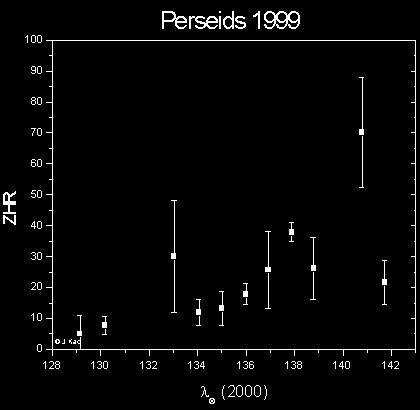Perseids 1999
In 1999 the Perseids were favoured by the new moon (and a total solar eclipse!) occuring on the day of maximum. MBK Team's efforts were reduced to zero by a front passing through during the peak night. The night after the peak, however, brought surprisingly strong activity. This was the first observational campaign of the MBK Team, and proved extremely successfull.
OBSERVATIONS
The activity builds up (August 4 - 11)
MBK Team monitored the Perseid activity from August 4 to August 16. During this time interval, no less than 8 observers were active. On the night of maximum, 5 observers were active. We were quite lucky to have clear weather from August 4 right up to August 11.
On August 4/5. only Jure Atanackov observed from his backyard, with poor LMs of around +5.0 and saw about 5 PER/h. Later, on August 5/6, similar activity with even worse LMs was seen by Jure Atanackov and Natasa Petelin. Meanwhile, Javor Kac saw only low activity with good conditions.
The next observing night, August 7/8, the rates were up to 15 PER/h, LM was down to +6.1 and also a -4m PER fireball with a 20 second train was seen. On August 8/9. Jure Atanackov observed again with LM +6.2, as well as Javor Kac, Jure Zakrajsek and Tina Bizjak who were at Mariborska Koca and had LMs down to +6.3. Perseid rates were up to 20/h. Also -6m and -4m PER fireballs was seen as well as a -3m sporadic fireball. On August 9/10. the same people observed from the same locations. Jure Atanackov saw up to 30 PER/h with LM +6.3 and about the same rate was seen from Mariborska Koca. Also there was at least one -3m PER fireball.
Jure Atanackov also observed on August 10/11 with LM +5.8 and the rates about 30 PER/h. No notable meteors were seen and there was constant interference from scattered clouds. Javor Kac observed from Janoshaza in Hungary during the solar eclipse expedition, with LMs around +6.8 and 35 PER/h.
Jure Atanackov observed again on Aug 11/12, but saw only up to 20 PER/h in spite of good LMs (+6.2), probably due to fatigue.
The peak night
On the peak night of August 12/13, 5 observers (ATAJU, ZAKJU, KACJA, BIZTI and BIZPO) gathered at Mariborska Koca. A cold front moved through during the night and we saw only rain and lightning - we had to spend the time with some other form of social activities. We went to bed at 7AM! J
The night after we expected lower activity, but since we had missed the peak, the spirits were still high and there was hope for good activity. And true to our hopes, there was a lot of activity! We had some problems with clouds during the early part of the night, but it cleared completely by midnight! LMs were down to +6.6. The top rate was seen by Jure Atanackov with 82 PER/h between 3:00 and 4:00 LT. There was a distinct increase in the number of faint Perseids, as the average magnitude was close to +4.0! No fireballs were seen, but three -2m PER were recorded, one of them leaving a 19 second train. Many near-simultaneous meteors. All in all, the activity the night after was great, almost as good as one would expect from the peak night!
Post-max observations
Jure Atanackov observed again on August 15/16 from his backyard with LMs down to +6.2 and 20 PER/h. The activity was still reasonably strong and the 2 hours were thoroughly enjoyable.
ANALYSIS

MBK Team observers successfully covered most of the Perseid activity. A ZHR profile was made from the observations using a population index r=2.6 (IMO: Handbook for visual meteor observers, 1995).
At the beginning of the month, the activity was low with ZHR around 5 to 10. Around l¤=133° (August 5/6) a pseudo-peak is seen with ZHR=30, an artifact of poor observing conditions by Jure Atanackov and Natasa Petelin. At the same time Javor Kac enjoyed better sky and a ZHR of 4, no more than the previous days. The activity increased thereafter, from ZHR 12 at l¤=134° up to 38 at l¤=138°. At l¤=139° (August 10/11) there is an apparent decline in activity, but again with a large error. Jure Atanackov observed in the evening hours and had a ZHR of 22, while Javor Kac observing after 00h UT saw a ZHR of 40.

The peak night lacks data due to obvious reasons, but we can take a look at the IMO results incorporated in Chart 2 - the peak of activity is at l¤=139,79° with ZHR=100. The activity of the Perseids was still very high the night after the peak, with an average ZHR of 70 with some periods up to 100, while IMO's calculated ZHR is only 60.
|



